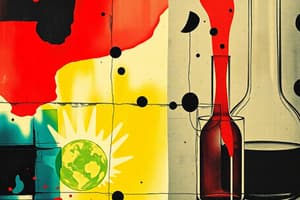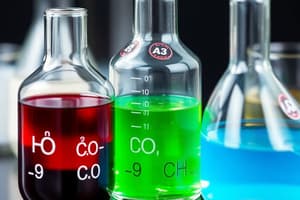Podcast
Questions and Answers
What type of oxides do most non-metals produce when dissolved in water?
What type of oxides do most non-metals produce when dissolved in water?
- Basic oxides
- Acidic oxides (correct)
- Amphoteric oxides
- Neural oxides
Metal oxides typically produce acidic solutions when dissolved in water.
Metal oxides typically produce acidic solutions when dissolved in water.
False (B)
What color flame does magnesium produce when burned in air?
What color flame does magnesium produce when burned in air?
Dazzling white flame
Most metals, when burned in air, produce __________.
Most metals, when burned in air, produce __________.
Which of the following is a characteristic of metals?
Which of the following is a characteristic of metals?
Match the metals with their properties:
Match the metals with their properties:
Sulphur produces an acidic solution when burned and dissolved in water.
Sulphur produces an acidic solution when burned and dissolved in water.
Name a metal that is a poor conductor of heat.
Name a metal that is a poor conductor of heat.
Which of the following metals reacts vigorously with oxygen?
Which of the following metals reacts vigorously with oxygen?
Aluminium oxide is amphoteric in nature.
Aluminium oxide is amphoteric in nature.
What is produced when copper reacts with oxygen?
What is produced when copper reacts with oxygen?
Sodium oxide reacts with water to form __________.
Sodium oxide reacts with water to form __________.
What is the chemical formula of aluminium oxide?
What is the chemical formula of aluminium oxide?
Match the metal with its corresponding oxide:
Match the metal with its corresponding oxide:
Most metal oxides are soluble in water.
Most metal oxides are soluble in water.
Which metals are typically kept in kerosene oil to prevent fires?
Which metals are typically kept in kerosene oil to prevent fires?
Which metal reacts vigorously with dilute hydrochloric acid?
Which metal reacts vigorously with dilute hydrochloric acid?
Copper can react with dilute hydrochloric acid to produce hydrogen gas.
Copper can react with dilute hydrochloric acid to produce hydrogen gas.
Which metal produced the highest temperature when reacting with dilute hydrochloric acid?
Which metal produced the highest temperature when reacting with dilute hydrochloric acid?
The reactivity of the metals with dilute acids decreases in the order of _______, ________, ________, _______.
The reactivity of the metals with dilute acids decreases in the order of _______, ________, ________, _______.
Match the following metals with their reactions with dilute hydrochloric acid:
Match the following metals with their reactions with dilute hydrochloric acid:
What is aqua regia primarily used for?
What is aqua regia primarily used for?
Hydrogen gas is evolved when magnesium reacts with very dilute nitric acid.
Hydrogen gas is evolved when magnesium reacts with very dilute nitric acid.
What happens to hydrogen gas when generated in a reaction involving nitric acid?
What happens to hydrogen gas when generated in a reaction involving nitric acid?
Which of the following metals is the most reactive according to the reactivity series?
Which of the following metals is the most reactive according to the reactivity series?
Iron is more reactive than copper according to the reactivity series.
Iron is more reactive than copper according to the reactivity series.
What is the purpose of keeping sodium immersed in kerosene oil?
What is the purpose of keeping sodium immersed in kerosene oil?
The displacement reaction can be represented as: Metal A + Salt solution of B → Salt solution of A + ______.
The displacement reaction can be represented as: Metal A + Salt solution of B → Salt solution of A + ______.
In the Activity series, which of the following metals is arranged as the least reactive?
In the Activity series, which of the following metals is arranged as the least reactive?
Aluminium is less reactive than calcium according to the activity series.
Aluminium is less reactive than calcium according to the activity series.
Name two metals that can displace copper from its salt solution.
Name two metals that can displace copper from its salt solution.
Match each metal with its reactivity level.
Match each metal with its reactivity level.
Which of the following metals is most reactive based on the provided table?
Which of the following metals is most reactive based on the provided table?
Metal D reacts with iron(II) sulfate.
Metal D reacts with iron(II) sulfate.
What gas is produced when dilute hydrochloric acid is added to a reactive metal?
What gas is produced when dilute hydrochloric acid is added to a reactive metal?
When zinc is added to iron(II) sulfate, zinc displaces iron and forms _______.
When zinc is added to iron(II) sulfate, zinc displaces iron and forms _______.
Match the metals to the respective reactions with Copper(II) sulfate:
Match the metals to the respective reactions with Copper(II) sulfate:
What would you observe if Metal B is added to a solution of Copper(II) sulfate?
What would you observe if Metal B is added to a solution of Copper(II) sulfate?
All metals tend to gain electrons to achieve a stable electronic configuration.
All metals tend to gain electrons to achieve a stable electronic configuration.
Write the chemical reaction when iron reacts with dilute H2SO4.
Write the chemical reaction when iron reacts with dilute H2SO4.
Study Notes
Chemical Properties of Metals
- Burning magnesium produces a basic oxide; testing with litmus paper confirms the solution is basic.
- Burning sulfur produces an acidic oxide; testing the resultant solution with litmus paper confirms acidity.
- Non-metals generally form acidic oxides in water, while metals yield basic oxides.
Metal Characteristics
- Metals are typically solid at room temperature, with mercury being a liquid exception.
- Malleability refers to the ability to be hammered into thin sheets.
- Ductility is the ability to be stretched into wires.
Reaction of Metals with Air
- Magnesium burns with a white flame, producing magnesium oxide.
- Different metals exhibit varying reactivities when burnt in air; some metals ignite easily while others do not.
- Products of metal combustion are usually metal oxides, which are generally basic.
Reactions of Metals with Water and Acids
- Metals react differently with dilute acids. Reactivity order with dilute hydrochloric acid is Mg > Al > Zn > Fe.
- Copper does not react with dilute hydrochloric acid, indicating low reactivity.
- Nitric acid does not evolve hydrogen gas when reacting with metals due to its strong oxidizing nature.
Amphoteric Oxides
- Some metal oxides, like aluminum oxide and zinc oxide, can behave as both acids and bases.
- Amphoteric oxides react with both acids and bases to form salts and water.
Reactivity Series of Metals
- The reactivity series ranks metals by their ability to displace less reactive metals in solution, from most to least reactive: K, Na, Ca, Mg, Al, Zn, Fe, Pb, H, Cu, Hg, Ag, Au.
- Potassium and sodium react vigorously with air and water, often stored under kerosene to prevent reactions.
Displacement Reactions
- Metals can displace metals that are less reactive from their compounds in solution.
- Observations from metal salt solutions confirm the relative reactivity: a more reactive metal displaces a less reactive one.
Testing and Observations
- In a displacement experiment, the metal wire and nail placed in different metal salt solutions change, indicating the reaction's occurrence.
- The outcome of displacement reactions can help to ascertain the reactivity order of various metals.
- Sodium is kept in kerosene to prevent fire hazards from its reactivity with moisture and air.
Understanding Reactivity
- Noble gases have stable electron configurations, leading to low reactivity.
- Metals tend to lose electrons to achieve a full outer shell, enhancing their reactivity.
Suggested Reactions
- Example reactions include magnesium with acid or steam, potassium with water, and iron with dilute sulfuric acid, producing hydrogen gas.
- Displacement reaction equations illustrate reactivity, such as zinc displacing iron in iron(II) sulfate solution.
Studying That Suits You
Use AI to generate personalized quizzes and flashcards to suit your learning preferences.
Related Documents
Description
This quiz explores the results of burning magnesium and sulfur and their effects on litmus paper. You will need to determine whether the solutions formed from these reactions are acidic or basic based on the litmus test. Test your knowledge of the chemistry behind these reactions!



